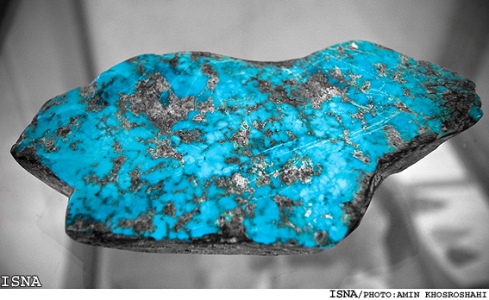In a story by Fatemeh Shokri & Atefeh Rezvan-Nia on Monday, “Iran Daily” said that majority of local people here have been engaged in extracting the precious stone from the city’s only mine that has a long history dating back to 5,000 years.
The archeological excavations, which took place 20 kilometers to the east of Neishabour in the historical site of Tappe Borj (Borj Hill), led to the discovery of a skeleton of a 25-year-old woman buried with turquoise stones.
With antiquity dating back to 3300 BCE, the stones have been extracted from Firouzeh mine.
The quality of turquoise extracted in the city of Firouzeh is not comparable with those produced elsewhere in the world.
There were rumors that the mine of turquoise had run out of the precious stone, which was denied by Mehdi Shurabi, the deputy head of Turquoise Union, which has recently been established. Iran Daily interviewed Shurabi.
Excerpts of the interview follow:
IRAN DAILY: When was the union established? How many members does the union have?
SHURABI: The union was established three years ago with the aim of organizing and supporting those who are involved in turquoise cutting. About 450 artisans are members of the union, of whom 253 have received working permission.
How many people are directly and indirectly involved in the industry?
Almost 1,000 people work in mines extracting the gem. Another 3,000 people are hired in jobs that are indirectly related to turquoise industry.
Why are the turquoise stones extracted in Firouzeh known as the richest and most valuable in the world?
Turquoise stones fall into three categories in the light of their color, namely green, blue and blue green.
Sky-blue turquoise, which is only found in Iran’s mines, has been identified as the world’s best of its kind. The unique color of Persian turquoise is because it has got a range of ores including iron oxide, manganese, aluminum, copper as well as water in it, which have healing properties. When ores come in contact with the skin, they reduce stress level and make people feel relaxed. The ores are also good for kidney, liver, eyes and internal glands.
However, just like any other products, the irregular import of fake Chinese turquoise has hurt Iran’s market in recent years.
China produces fake turquoise stones. People purchase them at low prices — assuming that they are similar to genuine ones.
Such fake products could pose risks to the health of customers, as they contain dangerous chemicals.
However, genuine and fake turquoises are identifiable, as the original turquoises have smooth, slippery surfaces and are transparent.
Those interested in buying original stones are recommended to buy them in centers supervised by Iran’s Cultural Heritage, Handicrafts and Tourism Organization.
What products are made with turquoise stones other than jewelries?
About 80 percent of precious stones are used in jewelries in Iran. The remaining 20 percent are used to produce vases, picture frames and praying beads.
Are there turquoise mines in other cities in Iran?
Iran is home to many turquoise mines. Some of these mines have been left intact, as their minerals are of very low quality. A mine in Kerman province produces a high-quality turquoise. However, its extracted stones are not used in jewelries because they contain limestone. As mentioned before, Firouzeh city is home to the world’s best gem stones and its minerals are used in jewelries.
How much turquoise is extracted from the mine of Firouzeh annually?
A company holds the monopoly of extracting turquoise from Firouzeh’s mine for 25 years, paying annual rent to the government. The company has the permission to extract up to 40 tons of stones per year. The company’s shareholders own a portion of extracted stones.
How much stone does the company give Turquoise Union per year?
About 15 out of 40 tons of extracted stones are given to craftsmen, who are members of the union and amounts of it are sold to independent artists via auctions or tenders.
The price of stones varies ― depending on their qualities.
What percentage of the stones are exported?
About 70 percent of rough stones are sold to domestic customers at auctions. The remaining 30 percent are exported after they are engraved and polished by artists.
However, there are a lot of dealers who smuggle rough turquoise to other countries, particularly European nations such as Italy.
Rough and unpolished stones are often sold at low price to foreigners by dealers.
A piece of polished stone has been reportedly sold at the price of one kilogram of smuggled rough stones at times.
What solution do you suggest for the problem?
The government can supply more stones for Turquoise Union through planning and inking deal with producing companies.
We seek to supply the stones for craftsmen to cut them and offer them to customers at actual prices.
The rough stones could be sold to the union at the price usually sold to foreigners by smugglers.
On the other hand, we need to apply modern technologies, such as water jet cutters to prevent damage to stones.
Explosion has been the only method for mining over the past 100 years in Iran, which inflicts considerable damages to the precious stones.
Sometimes, a piece of 10-gram turquoise is broken into small pieces each weighing two grams as the result of explosion.
Modern methods such as using laser for cutting through the stone are vital to extract precious stones with the least damages.
What are your future plans for boosting sales?
We have plans to set up a handicraft marketplace in the city of Firouzeh to sell polished and engraved stones at real prices to tourists.
Such marketplaces not only help omit the middlemen but also provide tourists with the opportunity to purchase genuine turquoise.
**1424

Tehran, June 28, IRNA - The city of Firouzeh near Neishabour in Khorasan Razavi province has established a global reputation for producing high quality ‘Firouzeh’ or ‘Turquoise’.

